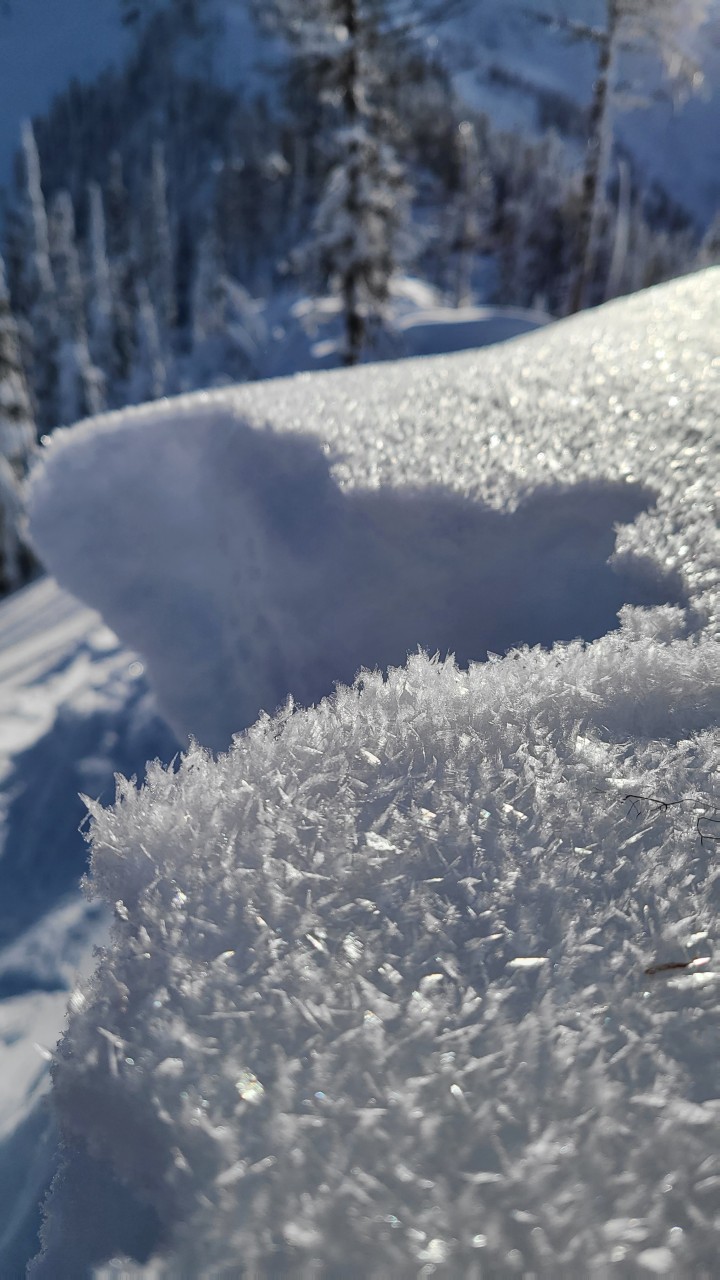7 Ways Surface Hoar Contributes to Avalanches
I often refer to surface hoar as the enemy of backcountry skiers. Most avalanche deaths in the Columbia Mountains are caused by surface hoar. "Know thy enemy" is a saying to apply to surface hoar. This article helps you understand this beautiful but deadly crystal.
Surface hoar refers to a type of frost crystal that forms on the surface of snow when conditions are right. It consists of feathery, beautiful and delicate ice crystals that grow vertically from the snow surface. Surface hoar typically forms during clear and calm nights when the air is cold enough to freeze and moisture condenses directly onto the snow. While it can create a picturesque scene, surface hoar can also lead to unstable snowpack conditions, potentially increasing the risk of avalanches in mountainous regions. Backcountry skiers need to be detectives and look for surface hoar whenever it may be present on a slope they wish to ride.
Surface hoar plays a significant role in avalanche formation due to its unique characteristics and effects on snow stability. Here's 7 detailed explanations of how surface hoar contributes to avalanches:
1. Crystal Structure:
Surface hoar crystals are fragile, flat, and feathery structures that resemble ferns or feathers. They grow vertically on the snow surface, forming a weak, easily disrupted layer.
2. Weak Bonding:
Surface hoar crystals have weak bonds between them and the underlying snowpack, making them prone to breaking or collapsing under stress. This weak bonding creates a potentially weak layer within the snowpack.
3. Load-Bearing:
As snow accumulates on top of the surface hoar layer, the added weight (load) from new snowfall or additional wind-deposited snow can increase stress on the already weakly bonded crystals.
4. Triggering Mechanisms:
The weak surface hoar layer can be a critical weak point within the snowpack. It can be triggered by various stressors, such as the weight of a skier, snowmobiler, or even natural factors like loading snow. These triggers can cause the surface hoar layer to break and lead to the initiation of an avalanche.
5. Propagation:
Once the surface hoar layer collapses or breaks, the fracture can propagate through the snowpack along interfaces. This propagation can often happen over 100's of meters across a slope and occur deep in the snowpack, leading to the release of large avalanches.
6. Resistance to bonding:
Surface hoar can take a very long time to heal and bond to the surrounding crystals. Once buried, surface hoar can take months (6-8 weeks can be common for large crystals) to bond to their surrounding crystals. The larger the crystal the longer it takes to heal.
7. Avalanche Risk:
The presence of surface hoar increases the potential for a persistent weak layer within the snowpack, making it more prone to avalanches. Avalanche forecasters closely monitor and assess the presence of surface hoar as part of their snowpack analysis to determine the avalanche risk in mountainous terrain.
A wise mentor of mine once said, "what is most important about surface hoar is whether or not it exists in the terrain you are trying to ride. Snowpack tests are less important that the fact that the surface hoar is present." Meaning, don't put all your eggs into the basket of snowpack tests when surface hoar is present in the snowpack. Simply avoid the slopes where it is present.
In summary, surface hoar contributes to avalanches by creating a weak layer within the snowpack that human and natural triggers can easily initiate. Surface hoar is hard to detect once buried, be a diligent backcountry detective and track surface hoar in the areas you play in before it is buried, once it is buried dig down and look for it before you drop in.
When you subscribe to the blog, we will send you an e-mail when there are new updates on the site so you wouldn't miss them.

